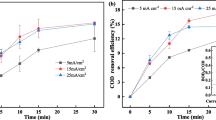Abstract
Pretreatment of waste emulsions with high organic content by a combined process of vibratory shear enhanced process and Fenton’s oxidation prior to biological treatment was investigated. Vibrating membrane had shown good performance in chemical oxygen demand and oil removals and the mitigation of concentration polarization. However, the permeate after filtration processing still contained high content of organics. Thus, additional Fenton oxidation was applied to reduce the organic loading, and improve the biodegradability of the wastewater. The optimal molar ratio of ferrous iron to hydrogen peroxide was 0.05 obtained from the jar-test experiments. Removal of organics was enhanced by increasing hydrogen peroxide dosage, while efficiency of hydrogen peroxide reached maximum of 1.11(w/w) at the hydrogen peroxide dosage of 6.8 g/L. Furthermore, the biological experiments indicated that the high concentration of organics could inhibit microbial activity, which decreased the chemical oxygen demand degradation rates. The adaptive period of the microbe was greatly shortened using Fenton’s reagent at the low dosages. The improvement of the biodegradability could be explained by partial mineralization and chemical transformation of parent organic compounds after Fenton oxidation.







Similar content being viewed by others
References
Adams CD, Cozzens RA, Kim BJ (1997) Effects of ozonation on the biodegradability of substituted phenols. Water Res 31(10):2655–2663
Al Akoum O, Jaffrin MY, Ding LH, Paullier P, Vanhoutte C (2002) An hydrodynamic investigation of microfiltration and ultrafiltration in a vibrating membrane module. J Membrane Sci 197(1–2):37–52
Aloui F, Kchaou S, Sayadi S (2009) Physicochemical treatments of anionic surfactants wastewater: effect on aerobic biodegradability. J Hazard Mater 164(1):353–359
Anderson JE, Kim BR, Mueller SA, Lofton TV (2003) Composition and analysis of mineral oils and other organic compounds in metalworking and hydraulic fluids. Crit Rev Environ Sci Tech 33(1):73–109
Belkacem M, Matamoros H, Cabassud C, Aurelle Y, Cotteret J (1995) New results in metal-working waste-water treatment using membrane technology. J Membrane Sci 106(3):195–205
Benito JM, Ebel S, Gutierrez B, Pazos C, Coca J (2001) Ultrafiltration of a waste emulsified cutting oil using organic membranes. Water Air Soil Pollut 128(1–2):181–195
Bautista P, Mohedano AF, Casas JA, Zazo JA, Rodriguez JJ (2008) An overview of the application of Fenton oxidation to industrial wastewaters treatment. J Chem Tech Biotech 83(10):1323–1338
De Laat J, Le GT, Legube B (2004) A comparative study of the effects of chloride, sulfate and nitrate ions on the rates of decomposition of H2O2 and organic compounds by Fe(II)/H2O2 and Fe(III)/H2O2. Chemosphere 55(5):715–723
Deegan AM, Shaik B, Nolan K, Urell K, Oelgemöller M, Tobin J, Morrissey A (2011) Treatment options for wastewater effluents from pharmaceutical companies. Int J Environ Sci Technol 8(3):649–666
Gharbani P, Tabatabaii SM, Mehrizad A (2008) Removal of Congo red from textile wastewater by ozonation. Int J Environ Sci Technol 5(4):495–500
Gogate PR, Pandit AB (2004) A review of imperative technologies for wastewater treatment I: oxidation technologies at ambient conditions. Adv Environ Res 8(3–4):501–551
Jaffrin MY (2008) Dynamic shear-enhanced membrane filtration: a review of rotating disks, rotating membranes and vibrating systems. J Membrane Sci 324(1–2):7–25
Janknecht P, Lopes AD, Mendes AM (2004) Removal of industrial cutting oil from oil emulsions by polymeric ultra- and microfiltration membranes. Environ Sci Technol 38(18):4878–4883
Kang YW, Hwang KY (2000) Effects of reaction conditions on the oxidation efficiency in the Fenton process. Water Res 34(10):2786–2790
Karakulski K, Kozlowski A, Morawski AW (1995) Purification of oily wastewater by ultrafiltration. Sep Technol 5(4):197–205
Kitis M, Adams CD, Daigger GT (1999) The effects of Fenton’s reagent pretreatment on the biodegradability of nonionic surfactants. Water Res 33(11):2561–2568
Lin SH, Lan WJ (1998) Waste oil/water emulsion treatment by membrane processes. J Hazard Mater 59(2–3):189–199
Lin SH, Lin CM, Leu HC (1999) Operating characteristics and kinetic studies of surfactant wastewater treatment by fenton oxidation. Water Res 33(7):1735–1741
Marchese J, Ochoa NA, Pagliero C, Almandoz C (2000) Pilot-scale ultrafiltration of an emulsified oil wastewater. Environ Sci Technol 34(14):2990–2996
Moulai-Mostefa N, Akoum O, Nedjihoui M, Ding L, Jaffrin MY (2007) Comparison between rotating disk and vibratory membranes in the ultrafiltration of oil-in-water emulsions. Desalination 206(1–3):494–498
Moulai-Mostefa N, Frappart M, Akoum O, Ding LH, Jaffrin MY (2010) Separation of water from metal working emulsions by ultrafiltration using vibratory membranes. J Hazard Mater 177(1–3):978–982
Neyens E, Baeyens J (2003) A review of classic Fenton’s peroxidation as an advanced oxidation technique. J Hazard Mater 98(1–3):33–50
Pignatello JJ, Oliveros E, MacKay A (2006) Advanced oxidation processes for organic contaminant destruction based on the Fenton reaction and related chemistry. Crit Rev Environ Sci Technol 36(1):1–84
Shon HK, Vigneswaran S, Snyder SA (2006) Effluent organic matter (EfOM) in wastewater: constituents, effects, and treatment. Crit Rev Environ Sci Technol 36(4):327–374
Siedlecka EM, Stepnowski P (2007) Effect of chlorides and sulfates on the performance of a Fe3+/H2O2 Fenton-like system in the degradation of methyl tert-butyl ether and its byproducts. Water Environ Res 79(11):2318–2324
Zhong J, Sun XJ, Wang CL (2003) Treatment of oily wastewater produced from refinery processes using flocculation and ceramic membrane filtration. Sep Purif Technol 32(1–3):93–98
Acknowledgments
This research was supported by grants from the National Natural Science Foundation of China (No. 5113808, 51008293). The authors also greatly appreciate financial support from the Shanghai Jihui Enviroment protection technology development co. Ltd.
Author information
Authors and Affiliations
Corresponding author
Electronic supplementary material
Below is the link to the electronic supplementary material.
Rights and permissions
About this article
Cite this article
Zhang, W.J., Zhang, M., Xiao, F. et al. Pretreatment of high strength waste emulsions by combined vibratory shear enhanced process with Fenton oxidation. Int. J. Environ. Sci. Technol. 11, 731–738 (2014). https://doi.org/10.1007/s13762-013-0217-0
Received:
Accepted:
Published:
Issue Date:
DOI: https://doi.org/10.1007/s13762-013-0217-0




